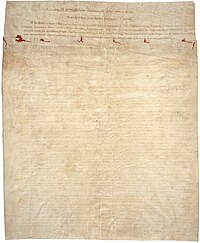
Back Qrinvill anlaşması Azerbaijani Vertrag von Greenville German Tratado de Greenville Spanish Traité de Greenville French Trattato di Greenville Italian 그린빌 조약 Korean Traktat z Greenville Polish Tratado de Greenville Portuguese Гринвилльский договор Russian Treaty of Greenville SIMPLE
| Treaty with the Wyandots, etc. | |
|---|---|
 | |
| Context | Northwest Indian War (1785-1795) |
| Signed | August 3, 1795 |
| Location | Fort Greenville Greenville, Ohio) |
| Ratified | December 22, 1795 |
| Parties | Wyandot Delaware Shawanee Odawa Chippewa Potawatomi Miami Eel Rivers Wea Kickapoo Piankeshaw Kaskaskia |
| Ratifiers | United States Senate |
| Language | English |
| Full text | |
The Treaty of Greenville, also known to Americans as the Treaty with the Wyandots, etc., but formally titled A treaty of peace between the United States of America, and the tribes of Indians called the Wyandots, Delawares, Shawanees, Ottawas, Chippewas, Pattawatimas, Miamis, Eel Rivers, Weas, Kickapoos, Piankeshaws, and Kaskaskias was a 1795 treaty between the United States and indigenous nations of the Northwest Territory (now Midwestern United States), including the Wyandot and Delaware peoples, that redefined the boundary between indigenous peoples' lands and territory for European American community settlement.
It was signed at Fort Greenville,[1] now Greenville, Ohio, on August 3, 1795, following the Native American loss at the Battle of Fallen Timbers a year earlier in August 1794. It ended the Northwest Indian War of 1785-1795 in the Ohio Country of the old Northwest Territory (1787-1803), and limited Indian country to remaining lands of northwestern Ohio, and began the practice of annual payments of goods, supplies and food, following the land concessions. The parties to the treaty were a coalition of Native American tribes known as the Western Confederacy, and the United States government represented by new United States Army General Anthony Wayne (1745-1796), and local frontiersmen.
The treaty became synonymous with the end of the American frontier in the eastern United States, in that part of the old Northwest Territory that would become the new state of Ohio and other adjacent future federal territories and future states around the Great Lakes and further west to the Mississippi River.
- ^ for Nathanael Greene, a Major General in the American Revolutionary War (1775-1783)